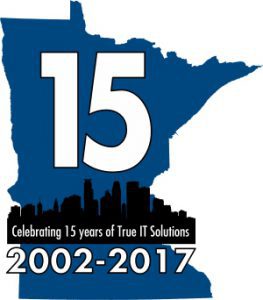Volume III, Issue 9 (September, 2017)
News & Notes
Attend our 15th Anniversary Celebration on Thursday, Oct. 12, 2017, for a chance to win a Polaris Sportsman 450 HO
 Join us Thursday, Oct 12, 2017, from 3:00 p.m. to 10:00 p.m. at Pinstripes-Edina for an afternoon of technical sessions, and an evening of fun, including casino games, bocce ball, bowling, great food and drinks, and awesome prize giveaways. One lucky attendee will walk (or drive) away with a Polaris Sportsman 450 HO.
Join us Thursday, Oct 12, 2017, from 3:00 p.m. to 10:00 p.m. at Pinstripes-Edina for an afternoon of technical sessions, and an evening of fun, including casino games, bocce ball, bowling, great food and drinks, and awesome prize giveaways. One lucky attendee will walk (or drive) away with a Polaris Sportsman 450 HO.  Many more great prize drawings will be held throughout the event. And the more activities you attend, the better your odds of winning!
Many more great prize drawings will be held throughout the event. And the more activities you attend, the better your odds of winning!
The agenda for the event is:
3:00 to 5:00 p.m.: Technical sessions. Please join us as Corey Nachreiner, Chief Technology Officer, and Ryan Orsi, Director of Strategic Alliances, from WatchGuard present on Ransomware and Secure Wi-Fi solutions, and then Tony Klein, Product Sales Specialist, and Mike Bentle, Spark Video Specialist, of Cisco present on their Spark Board collaboration technology.
 5:00 to 6:00 p.m.: Social hour – Enjoy fine food and drinks on us.
5:00 to 6:00 p.m.: Social hour – Enjoy fine food and drinks on us.
6:00 to 10:00 p.m.: Continue to eat and drink while enjoying blackjack, poker, other card games, or enjoy bocce ball, bowling, and other games provided by Verus.
To sign up, please email events@veruscorp.com and indicate whether you plan to attend the technical sessions from 3:00 to 5:00 p.m., the party from 5:00 to 10:00 p.m., or both.
For more information, visit here.
A big thank you to our sponsors, who are helping us celebrate 15 years of TRUE IT Solutions!
PLATINUM SPONSOR

GOLD SPONSOR

SILVER SPONSORS



BRONZE SPONSOR
![]()
August Customer Survey drawing winner announced – Don’t miss out on your chance to win!
 In a continued effort to improve our customer service and technical skills at Verus, we are please to announce the winner of the August monthly customer service survey drawing. Congratulations to David Hauer of Phillips & Temro Industries!
In a continued effort to improve our customer service and technical skills at Verus, we are please to announce the winner of the August monthly customer service survey drawing. Congratulations to David Hauer of Phillips & Temro Industries!
Each month, Verus does a random drawing of all customers who filled out the customer satisfaction survey in that month, and the winner receives a prize worth $50 – whether that’s a drone, a personal firewall, a gift card to a local business – the prizes will change each month to keep people interested.
Best Practices Corner
Be the Boy Scout of your Business’s Information Technology: Be Prepared!
 With Hurricanes Harvey and Irma hitting different sectors of the southern coast, an earthquake hitting Mexico and parts of the southern U.S., and wildfires ravaging in the Pacific Northwest and California, it’s a good reminder to get your ducks in a row in the event of a natural disaster. While Minnesota isn’t known for the bigger natural disasters in today’s headlines, one can never predict natural disasters that could impact your business. This is a case where being over-prepared is your best approach.
With Hurricanes Harvey and Irma hitting different sectors of the southern coast, an earthquake hitting Mexico and parts of the southern U.S., and wildfires ravaging in the Pacific Northwest and California, it’s a good reminder to get your ducks in a row in the event of a natural disaster. While Minnesota isn’t known for the bigger natural disasters in today’s headlines, one can never predict natural disasters that could impact your business. This is a case where being over-prepared is your best approach.
There is no perfect plan for all businesses to follow. Much of your preparedness should be dictated by what you currently have. If you’re already using an off-site back up to a data center halfway across the country, you’ll have a different approach for your business continuity than a company running their backups to a NAS. And if it costs you millions of dollars per day to be down as a business, you’ll have a different approach than a company who might only be losing a smaller amount per day.
The bigger picture question is this – do you have a plan? If your office is destroyed tonight by flooding, or a tornado, or a fire, what would be your first step tomorrow morning?
The three phases of ensuring you can survive a natural disaster include 1) planning, 2) implementation, and 3) recovery.
But without the planning, implementation and recovery are useless. Therefore, Verus has a few guidelines to help you start building your disaster recovery plan:
IT Disaster Recovery planning involves a thorough analysis of existing network structure, applications, databases, equipment, organization setup, and related details. It is important to define in the document about the key components involved in the business, the disaster recovery team personnel with contact details, recovery time objective, and communication methods at the time of the disaster, alternative facility for the organization, and master list of all inventory, storage locations, customer/vendor, forms and policies. The following are the steps that should be taken in IT disaster recovery planning:
- Constitute a Disaster Recovery Team: The organization should form a DR team that will assist in the entire disaster recovery operations. The team should be composed of core members from all departments with representative from the top management. The team will also be responsible for overseeing the development and implementation of the DR plan.
- Perform Risk Assessment: A risk analysis and business impact analysis should be conducted, which includes in scope the possible disasters, both natural and man made. By conducting an analysis of the impact and aftermath in disaster scenarios, the security of crucial resources can be determined.
- Prioritize Processes and Operations: The organization’s critical requirements pertaining to each department must be determined with respect to data, documentation, services, processes, operations, vital resources, and policies/procedures. They should all be categorized and ordered based on priority as Essential, Important, and Non-essential.
- Data Collection: The complete data about the organization must be gathered and documented. It should include inventory of forms, policies, equipment, communications; important telephone numbers, contact details, and customer details; equipment, systems, applications and resources description; onsite and offsite location; details of backup storage facility and retention schedules; and other material and documentation.
- Creating the Disaster Recovery Plan: The DR plan should be created in a standard format that would enable detailing of procedures and including essential information. All important procedures should be completely outlined and explained in the plan. The plan should have step-by-step details of what is to be done when the disaster strikes. It should also comprise procedures for maintaining and updating of the plan, with regular review by the Disaster Recovery team and top personnel of the organization.
- Testing the Plan: The developed Disaster Recovery Plan should be tested for efficiency. Testing provides a platform wherein an analysis can be done as to what changes are required and make appropriate adjustments to the plan. The plan can be tested using different types of tests such as Checklist tests, Simulation tests, Parallel tests, Full interruption tests, etc.
Once you’ve got your plan squared up, then you can rest a little easier at night knowing you’ll be ready for the unexpected.
Industry News
Tegile agrees to be acquired by Western Digital
 Western Digital Corp. and Tegile Systems announced August 29, 2017, that they have entered into a definitive agreement under which Tegile, a leading provider of flash and persistent-memory storage solutions for enterprise data center applications, will be acquired by Western Digital. Financial terms of the transaction were not disclosed. The acquisition is expected to close the week of Sept. 4, 2017, upon satisfaction of certain closing conditions as set forth in the definitive agreement between the parties. Tegile has been at the forefront of the flash storage revolution since 2012. With its award winning IntelliFlash™ architecture, Tegile has pioneered a comprehensive storage platform that delivers storage at the speed of flash memory. Tegile will bring to Western Digital over 1,700 new customers, an innovative product portfolio, and a deeply experienced team with a proven ability to deliver value to customers. Rohit Kshetrapal, chief executive officer of Tegile said, “Western Digital has been a key partner and long-term investor in Tegile and has already enhanced various aspects of Tegile’s business, including engineering integration, HDD/SSD supply chain efficiencies, go-to-market efforts and customer support. Both Tegile and Western Digital have introduced industry-changing storage products. The Tegile team looks forward to continuing this tradition of innovation as part of the Western Digital family.”
Western Digital Corp. and Tegile Systems announced August 29, 2017, that they have entered into a definitive agreement under which Tegile, a leading provider of flash and persistent-memory storage solutions for enterprise data center applications, will be acquired by Western Digital. Financial terms of the transaction were not disclosed. The acquisition is expected to close the week of Sept. 4, 2017, upon satisfaction of certain closing conditions as set forth in the definitive agreement between the parties. Tegile has been at the forefront of the flash storage revolution since 2012. With its award winning IntelliFlash™ architecture, Tegile has pioneered a comprehensive storage platform that delivers storage at the speed of flash memory. Tegile will bring to Western Digital over 1,700 new customers, an innovative product portfolio, and a deeply experienced team with a proven ability to deliver value to customers. Rohit Kshetrapal, chief executive officer of Tegile said, “Western Digital has been a key partner and long-term investor in Tegile and has already enhanced various aspects of Tegile’s business, including engineering integration, HDD/SSD supply chain efficiencies, go-to-market efforts and customer support. Both Tegile and Western Digital have introduced industry-changing storage products. The Tegile team looks forward to continuing this tradition of innovation as part of the Western Digital family.”
Cisco unveils industry-first security features for Spark collaboration space
 Cisco last month unveiled a set of new security features for its Spark platform that it says are unprecedented in the cloud collaboration space. The new capabilities, years in the making, “set a new bar for enterprise-grade security for collaboration tools,” Cisco CTO Jonathan Rosenberg said. First, Cisco is giving customers the ability to host on-premise encryption keys for securing content on the Spark platform. The feature was four years in the making and amounts to “a new market capability that has never existed for a cloud product before, which is data security equivalent to on-prem storage,” Rosenberg said. End-to-end encryption is already available for Cisco Spark. Now, a customer can have their encryption keys sit on premise, run by the enterprise administrator, rather than on the Cisco Spark cloud. In order for an attacker to gain access to a customer’s data, they’d have to breach Cisco databases, as well as the customer’s on-premise system simultaneously. “There’s no such thing as a system that’s 100 percent secure,” Rosenberg said. “This is a solution for a category of customers that are worried about a set of risks inherent in large-scale SaaS-based content storage and cloud systems.”
Cisco last month unveiled a set of new security features for its Spark platform that it says are unprecedented in the cloud collaboration space. The new capabilities, years in the making, “set a new bar for enterprise-grade security for collaboration tools,” Cisco CTO Jonathan Rosenberg said. First, Cisco is giving customers the ability to host on-premise encryption keys for securing content on the Spark platform. The feature was four years in the making and amounts to “a new market capability that has never existed for a cloud product before, which is data security equivalent to on-prem storage,” Rosenberg said. End-to-end encryption is already available for Cisco Spark. Now, a customer can have their encryption keys sit on premise, run by the enterprise administrator, rather than on the Cisco Spark cloud. In order for an attacker to gain access to a customer’s data, they’d have to breach Cisco databases, as well as the customer’s on-premise system simultaneously. “There’s no such thing as a system that’s 100 percent secure,” Rosenberg said. “This is a solution for a category of customers that are worried about a set of risks inherent in large-scale SaaS-based content storage and cloud systems.”
Food for Thought
Bring the taste of Autumn to your table with Cider-Braised Chicken, Brussels Sprouts and Apples
 Makes: 4 servings
Makes: 4 servings
Hands On 15 mins
Total Time 55 mins
Ingredients:
- 4 slices bacon, chopped
- 8 bone-in, skin-on chicken thighs (about 3 1/2 pounds total)
- 2 medium tart red apples, cored and cut into wedges
- 1 12 – ounce bottle hard cider
- 2 tablespoons chopped fresh thyme
- 2 tablespoons whole grain mustard
- 1 teaspoon kosher salt
- 12 ounces fresh Brussels sprouts, trimmed and halved if large (2 cups)
Directions:
- In a very large skillet cook bacon over medium heat until crisp; remove from pan, reserving drippings in skillet. Add chicken, skin side down, and cook 10 minutes or until browned, turning once; remove from skillet. Add apples to the skillet and cook 4 minutes or until browned on both sides; remove from skillet. Drain and discard drippings from skillet.
- Add cider, thyme, mustard, and salt to skillet, scraping up any browned bits. Bring to boiling; reduce heat. Return chicken to skillet. Cover and simmer 10 minutes. Add Brussels sprouts. Cover and cook 5 minutes. Add apples and cook, uncovered, 3 to 5 minutes more or until chicken is done (at least 175 degrees F).
- To serve, divide chicken thighs, Brussels sprouts, and apples among shallow bowls or plates. Spoon cider mixture over top. Sprinkle each serving with bacon.
PRO TIP: Substitute pork chops for the chicken for an easy change-up.
Good Medicine



